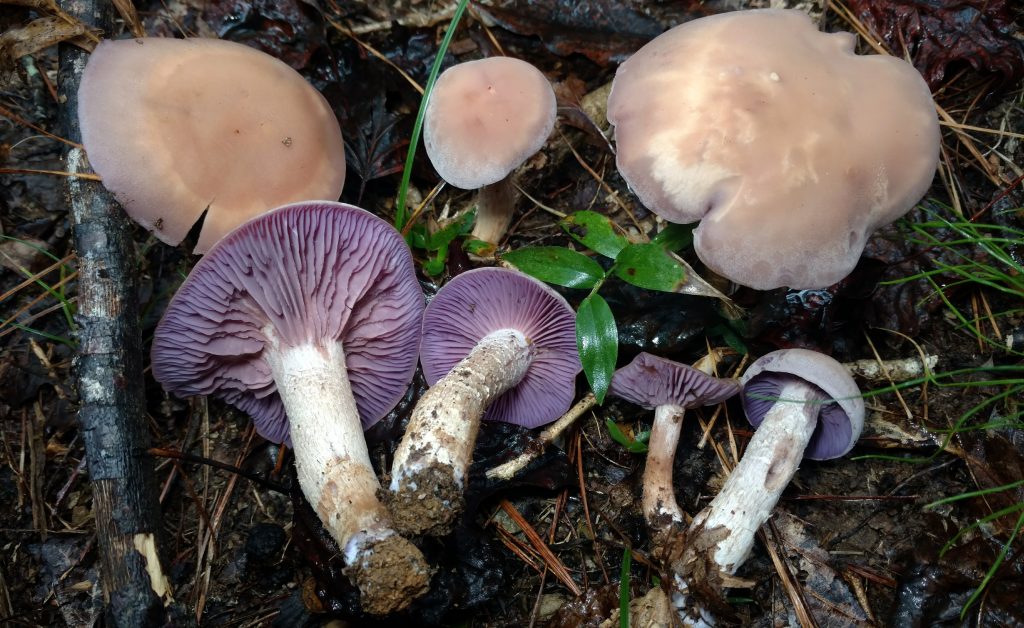Laccaria ochropurpurea, commonly known as the purple-gilled Laccaria or the purple-ochre tallowgill, is a medium to large, edible mushroom that is frequently found in association with hardwood trees in eastern North America. It is characterized by a purplish-brown to a grayish cap, thick purplish gills, and a distinctive, stout, solid stalk that is just a bit too big for its cap. [i]
This species was first described by the English plant cryptogamist and plant pathologist Miles Joseph Berkeley in 1896.
Identification and Description [ii]
The purple-ochre tallowgill is tricky to recognize as it lacks distinctive characteristics and is variable in its colors and size. Therefore, foragers must take into account all of its identifying characteristics such as its rapidly fading cap, purplish colors, thick gills, size, and habitat to have any chance at truly identifying this species.
Cap: The cap of this species is broadly convex with an incurved margin at first, however, with age the cap becomes flat with irregularly flaring limb and margin as well as a shallowly depressed disc (center). The surface of the cap is nearly smooth or finely hairy-scaly. The color of younger specimens is purple or light lilac brown, which quickly fades to light brownish or nearly white or grayish white. The cap measures 3 to 12 cm in diameter.
Flesh: The flesh of L. ochropurpurea is firm. It may be watery when fresh.
Gills: The gills of this species are adnate (broadly attached) or subdecurrent (attached slightly down the stem) and are nearly distant. They are waxy and thick. The gills are purple when young, but they soon fade to a purplish white color, sometimes due to dusting from its white spores.
Stem: The stem of Laccaria ochropurpurea is pronounced and is often larger than what one would expect for a mushroom with a similar cap size. It measures 4-19 cm in length and is approximately 0.5-2.5 cm in thickness. It may be equally cylindrical or slightly bulbous at the bottom, and it may also be curved. The texture of the stem is firm, dry, and smooth to slightly scaly/hairy. In color, the stem can be concolorous with the surface of the cap, although it may discolor to a brownish or reddish-brown color.
Spore: The spores of this species are subglobose to globose, have spines (echinulate) that measure 1-2µm in length, and are colorless. They measure 7-9 µm by 6-9 µm in size.
Spore Print: The spore print of this species is white to purplish white..
Flavor and Edibility: Laccaria ochropurpurea is considered edible, but by no means is it considered a “choice edible”. Unfortunately, their stems are stringy and tough as such only their caps are usable which significantly reduces their yield. Furthermore, specimens may be infested with bugs which makes them inedible. Overall, the flesh of the mushroom is meaty but is nearly flavorless. As such it is mostly mixed with other foods.
Smell: This species does not have a distinctive odor.
Habitat: The purple-ochre tallowgill is mycorrhizal with hardwood trees, especially oaks, and beeches. As such, it is frequently found in grassy areas under them either growing alone, scattered, or gregariously.
Range: In North America, this species is most commonly found east of the Rocky Mountains and the great plains in midwestern, southern, southeastern, and northeastern states.
Fruiting Season: Laccaria ochropurpurea fruits from late summer to fall (July-November).
Look-A-likes [iii]
This tallowgill is fairly common, but its great variability and lack of truly distinctive characters make it difficult to recognize. A combination of rapidly fading, purplish colors, size, habitat, and the somewhat waxy, thick gills helps to distinguish it from other tallowgills from the species of Laccaria and numerous species in other genera such as Cortinarius.
One species, Cortinarius alboviolaceus, is frequently confused for L. ochropurpurea. Fortunately, the former species has a distinctive rust-brown spore print as well as a cobweb-like cap.
Laccaria amethystina is similar. It is smaller than L. ochropurpurea and is purple both on the cap surface and undersurface.
References:
[i] McKnight, K. H., & McKnight, V. B. (1998). Purple-Ochre Tallowgill. In A Field Guide to Mushrooms, North America (pp. 157). Houghton Mifflin.
[ii] Kuo, M. (2010, December). Laccaria ochropurpurea.
[iii] Lincoff, G. (1981). Purple-gilled Laccaria. In National Audubon Society Field Guide to North American mushrooms (pp. 762-763). Knopf.




